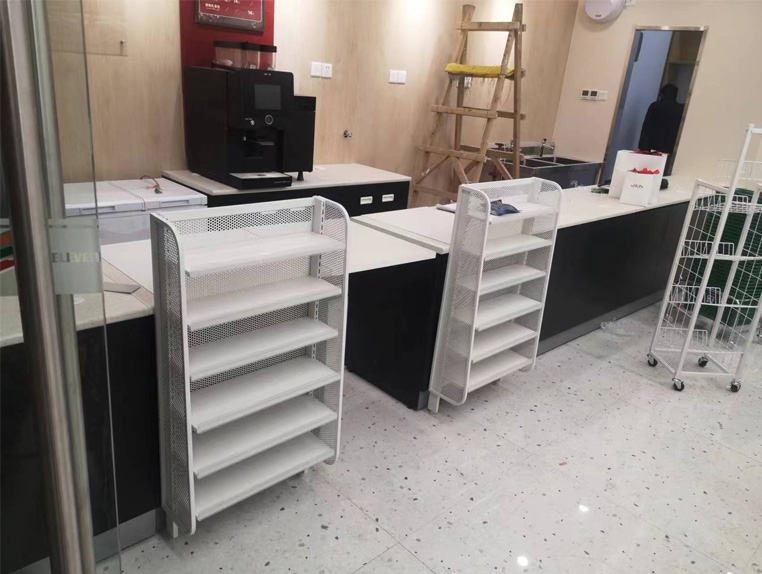You Are Here:Home > Information dynamics
> Industry dynamics
NEWS CENTER
Recommended news
- Where are the customized display shelves mainly used
- How to promote commodity sales on the shelves of wanghong snack shop
- What are the applications of medium-sized storage shelves in logistics centers
- What are the main uses of lightweight storage shelves
- How is the display effect of the island shelves in the mother and baby area
Recommended products
What are the applications of heavy-duty storage shelves in the logistics industry
source:www.hanming.net.cn | Release time:2024-11-12
Heavy duty storage shelves are widely used in the logistics industry, as follows:
1. Storage and Preservation of Goods:
Storage of heavy goods: Heavy storage shelves have strong load-bearing capacity and can safely store various heavy goods, such as mechanical components, metal products, building materials, automotive parts, etc. These goods are heavy and difficult for ordinary shelves to bear, while heavy-duty shelves can ensure stable storage of goods and avoid damage or safety accidents caused by shelf collapse and other issues.
Storing bulk goods: For logistics companies, they often need to handle large quantities of goods. Heavy duty storage shelves can centrally store these goods, fully utilize the vertical space of the warehouse, increase storage capacity, and meet the storage needs of logistics enterprises for bulk goods. For example, in e-commerce logistics warehouses, a large number of goods can be stored on heavy-duty shelves for unified management and allocation.
2. Goods sorting and classification:
Convenient goods differentiation: There are various types of goods in the logistics warehouse that need to be sorted and classified. Heavy duty storage shelves can be stored in different shelf areas or shelves based on the different attributes of the goods, such as weight, size, category, etc., for easy identification and sorting by staff. For example, storing small items on the top shelf and heavy goods on the bottom shelf not only facilitates access but also improves sorting efficiency.
Improve sorting speed: During the sorting process of goods, staff can use forklifts and other handling equipment to quickly access and retrieve goods on heavy shelves, reducing the time and labor intensity of manual handling and improving sorting speed. Meanwhile, the layout and design of shelves can also affect sorting efficiency. Reasonable shelf placement can make sorting routes smoother and further improve the speed of logistics operations.
3. Warehouse layout and space utilization:
Optimizing warehouse space: The space of logistics warehouses is limited, and how to make reasonable use of space is the key to improving warehousing efficiency. Heavy duty storage shelves can be customized and installed according to the actual size and shape of the warehouse, making full use of the warehouse space and improving space utilization. For example, in some warehouses with higher heights, high-rise heavy-duty shelves can be installed to increase the number of storage layers and expand storage capacity.
Forming a channel layout: The placement of heavy-duty shelves can create channels within the warehouse, facilitating the passage of forklifts and other handling equipment. Reasonable channel layout can reduce the travel distance and time of handling equipment, and improve the efficiency of logistics operations. At the same time, the width of the channel and the spacing between the shelves also need to be designed according to the size and operational requirements of the handling equipment to ensure that the equipment can pass smoothly.
4. Goods inbound and outbound management:
Facilitating the operation of goods in and out of the warehouse: The structural design of heavy-duty storage shelves makes the operation of goods in and out of the warehouse more convenient and efficient. Forklifts and other handling equipment can directly remove or store goods from the shelves, reducing the number of times goods are handled and the risk of damage. At the same time, the identification and numbering on the shelves can help staff quickly locate the required goods, improving the accuracy and efficiency of inbound and outbound storage.
Support for access management: For goods with shelf life requirements or requiring access management, heavy-duty storage shelves can achieve the entry and exit of goods through reasonable layout and design. For example, storing goods on shelves in the order of their arrival time, with the first to arrive goods stored at the front end of the shelf and the second to arrive goods stored at the back end. This ensures that the first to arrive goods are released first when leaving the warehouse, avoiding expiration or backlog of goods.
5. Application of logistics distribution centers:
Temporary storage and transfer of goods: At the logistics distribution center, goods need to be temporarily stored and transferred. Heavy duty storage shelves can provide temporary storage space for these goods, ensuring their safety and orderliness. At the same time, the distribution center can store goods in different shelf areas according to their flow and delivery needs, facilitating subsequent distribution and transportation.
Supporting containerized transportation: Containerized transportation methods such as pallet transportation and container transportation are widely used in the logistics industry. Heavy duty storage shelves can be combined with container unit equipment to facilitate the loading, unloading, and handling of goods. For example, by placing goods on pallets and storing them on shelves, forklifts can directly transport the pallets and goods together, improving the efficiency and standardization of logistics operations.
1. Storage and Preservation of Goods:
Storage of heavy goods: Heavy storage shelves have strong load-bearing capacity and can safely store various heavy goods, such as mechanical components, metal products, building materials, automotive parts, etc. These goods are heavy and difficult for ordinary shelves to bear, while heavy-duty shelves can ensure stable storage of goods and avoid damage or safety accidents caused by shelf collapse and other issues.
Storing bulk goods: For logistics companies, they often need to handle large quantities of goods. Heavy duty storage shelves can centrally store these goods, fully utilize the vertical space of the warehouse, increase storage capacity, and meet the storage needs of logistics enterprises for bulk goods. For example, in e-commerce logistics warehouses, a large number of goods can be stored on heavy-duty shelves for unified management and allocation.
2. Goods sorting and classification:
Convenient goods differentiation: There are various types of goods in the logistics warehouse that need to be sorted and classified. Heavy duty storage shelves can be stored in different shelf areas or shelves based on the different attributes of the goods, such as weight, size, category, etc., for easy identification and sorting by staff. For example, storing small items on the top shelf and heavy goods on the bottom shelf not only facilitates access but also improves sorting efficiency.
Improve sorting speed: During the sorting process of goods, staff can use forklifts and other handling equipment to quickly access and retrieve goods on heavy shelves, reducing the time and labor intensity of manual handling and improving sorting speed. Meanwhile, the layout and design of shelves can also affect sorting efficiency. Reasonable shelf placement can make sorting routes smoother and further improve the speed of logistics operations.
3. Warehouse layout and space utilization:
Optimizing warehouse space: The space of logistics warehouses is limited, and how to make reasonable use of space is the key to improving warehousing efficiency. Heavy duty storage shelves can be customized and installed according to the actual size and shape of the warehouse, making full use of the warehouse space and improving space utilization. For example, in some warehouses with higher heights, high-rise heavy-duty shelves can be installed to increase the number of storage layers and expand storage capacity.
Forming a channel layout: The placement of heavy-duty shelves can create channels within the warehouse, facilitating the passage of forklifts and other handling equipment. Reasonable channel layout can reduce the travel distance and time of handling equipment, and improve the efficiency of logistics operations. At the same time, the width of the channel and the spacing between the shelves also need to be designed according to the size and operational requirements of the handling equipment to ensure that the equipment can pass smoothly.
4. Goods inbound and outbound management:
Facilitating the operation of goods in and out of the warehouse: The structural design of heavy-duty storage shelves makes the operation of goods in and out of the warehouse more convenient and efficient. Forklifts and other handling equipment can directly remove or store goods from the shelves, reducing the number of times goods are handled and the risk of damage. At the same time, the identification and numbering on the shelves can help staff quickly locate the required goods, improving the accuracy and efficiency of inbound and outbound storage.
Support for access management: For goods with shelf life requirements or requiring access management, heavy-duty storage shelves can achieve the entry and exit of goods through reasonable layout and design. For example, storing goods on shelves in the order of their arrival time, with the first to arrive goods stored at the front end of the shelf and the second to arrive goods stored at the back end. This ensures that the first to arrive goods are released first when leaving the warehouse, avoiding expiration or backlog of goods.
5. Application of logistics distribution centers:
Temporary storage and transfer of goods: At the logistics distribution center, goods need to be temporarily stored and transferred. Heavy duty storage shelves can provide temporary storage space for these goods, ensuring their safety and orderliness. At the same time, the distribution center can store goods in different shelf areas according to their flow and delivery needs, facilitating subsequent distribution and transportation.
Supporting containerized transportation: Containerized transportation methods such as pallet transportation and container transportation are widely used in the logistics industry. Heavy duty storage shelves can be combined with container unit equipment to facilitate the loading, unloading, and handling of goods. For example, by placing goods on pallets and storing them on shelves, forklifts can directly transport the pallets and goods together, improving the efficiency and standardization of logistics operations.
Previous:
What are the characteristics of a convenience sto…
Next:
What industries are heavy-duty storage shelves su…
【Related articles】
【Related Products】
Consultation hotline0512-52436990

- Product series
- Storage shelves
- Supermarket shelves
- Scenario display
- Supermarket shelves
- Cashier
- Wall shelf
- product display
- other parts
- product display
- Kitchen supplies
- Cleaning supplies
- Fruit and vegetable food
- Maternal and Child Home Furnishings
- About Us
- Website homepage
- About Us
- Contact Us
- News Center
- MESSAGE
 WeChat:
WeChat:










 home
home
 WeChat
WeChat
 telephone
telephone